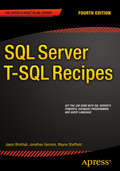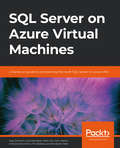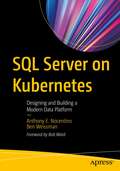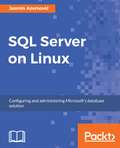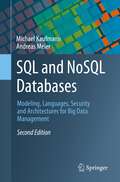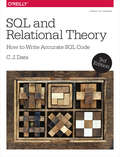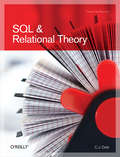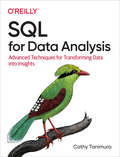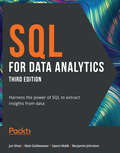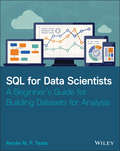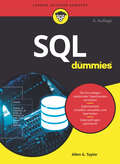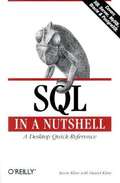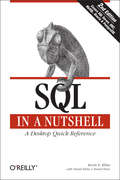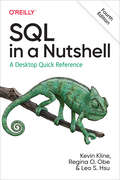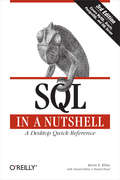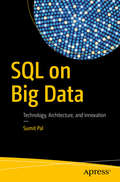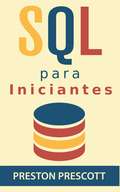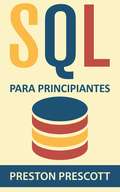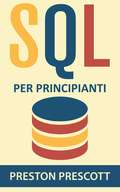- Table View
- List View
SQL Server T-SQL Recipes
by Jonathan Gennick Jason Brimhall Wayne SheffieldSQL Server T-SQL Recipes is an example-based guide to the Transact-SQL language that is at the core of SQL Server. This edition has been lightly updated for SQL Server 2014 and provides ready-to-implement solutions to common programming and database administration tasks. Learn to create databases, create in-memory tables and stored procedures, insert and update data, generate reports, secure your data, and more. Tasks and their solutions are broken down into a problem/solution format that is quick and easy to read so that you can get the job done fast when the pressure is on. Solutions in this book are divided into chapters by problem domain. Each chapter is a collection of solutions around a single facet of the language such as writing queries, managing indexes, error handling, and query performance. Each solution is presented code-first, giving you a working code example to copy from and implement immediately in your own environment. Following each example is an in-depth description of how and why the given solution works. Tradeoffs and alternative approaches are also discussed. Focused on solutions: Look up what you need to do. Learn how to do it. Do it. Current: Lightly updated for SQL Server 2014 Comprehensive: Covers all common T-SQL problem domains What you'll learn Create databases, tables, and indexes Query and manipulate data Move business logic into the database Build reports that matter to your business. Perform common backup and recovery tasks Take advantage of window functions in your SQL Who this book is for SQL Server T-SQL Recipes is aimed at technically-oriented users of SQL Server desiring to extract the full power of the platform through it's powerful, built-in programming and scripting language. Target readers include developers who use SQL Server as their back-end database platform, and the database administrators who create, manage, and secure those databases. Table of Contents 1. Getting Started with SELECT 2. Elementary Programming 3. Working with NULLS 4. Combining Data from Multiple Tables 5. Aggregations and Grouping 6. Advanced SELECT Techniques 7. Windowing 8. Inserting, Updating, Deleting 9. Working with Strings 10. Working with Dates 11. Working with Numbers 12. Transactions, Locking, Blocking, Deadlockin 13. Managing Tables 14. Managing Views 15. Managing Indexes 16. Managing Large Tables 17. Stored Procedures 18. User-Defined Functions 19. In-Memory T-SQL 20. Triggers 21. Error Handling 22. Query Performance 23. Hints 24. Index Tuning and Statistics 25. XML 26. Files, Filegroups, and Integrity 27. Backup 28. Recovery 29. Principals and Users 30. Securables and Permissions 31. Objects and Dependencies
SQL Server on Azure Virtual Machines: A hands-on guide to provisioning Microsoft SQL Server on Azure VMs
by Allan Hirt John Martin Louis Davidson Joey D'Antoni Anthony Nocentino Tim Radney Randolph WestLearn how to combine SQL Server's analytics with Azure's flexibility and hybrid connectivity to achieve industry-leading performance and manageability for your cloud database. Key Features Understand platform availability for SQL Server in Azure Explore the benefits and deployment choices offered by SQL IaaS Get to grips with deploying SQL Server on the Linux development ecosystem Book Description Deploying SQL Server on Azure virtual machines allows you to work on full versions of SQL Server in the cloud without having to maintain on-premises hardware. The book begins by introducing you to the SQL portfolio in Azure and takes you through SQL Server IaaS scenarios, before explaining the factors that you need to consider while choosing an OS for SQL Server in Azure VMs. As you progress through the book, you'll explore different VM options and deployment choices for IaaS and understand platform availability, migration tools, and best practices in Azure. In later chapters, you'll learn how to configure storage to achieve optimized performance. Finally, you'll get to grips with the concept of Azure Hybrid Benefit and find out how you can use it to maximize the value of your existing on-premises SQL Server. By the end of this book, you'll be proficient in administering SQL Server on Microsoft Azure and leveraging the tools required for its deployment. What you will learn Choose an operating system for SQL Server in Azure VMs Use the Azure Management Portal to facilitate the deployment process Verify connectivity and network latency in cloud Configure storage for optimal performance and connectivity Explore various disaster recovery options for SQL Server in Azure Optimize SQL Server on Linux Discover how to back up databases to a URL Who this book is for SQL Server on Azure VMs is for you if you are a developer, data enthusiast, or anyone who wants to migrate SQL Server databases to Azure virtual machines. Basic familiarity with SQL Server and managed identities for Azure resources will be a plus.
SQL Server on Kubernetes: Designing and Building a Modern Data Platform
by Ben Weissman Anthony E. NocentinoBuild a modern data platform by deploying SQL Server in Kubernetes. Modern application deployment needs to be fast and consistent to keep up with business objectives and Kubernetes is quickly becoming the standard for deploying container-based applications, fast. This book introduces Kubernetes and its core concepts. Then it shows you how to build and interact with a Kubernetes cluster. Next, it goes deep into deploying and operationalizing SQL Server in Kubernetes, both on premises and in cloud environments such as the Azure Cloud.You will begin with container-based application fundamentals and then go into an architectural overview of a Kubernetes container and how it manages application state. Then you will learn the hands-on skill of building a production-ready cluster. With your cluster up and running, you will learn how to interact with your cluster and perform common administrative tasks. Once you can admin the cluster, you will learn how to deploy applications and SQL Server in Kubernetes. You will learn about high-availability options, and about using Azure Arc-enabled Data Services. By the end of this book, you will know how to set up a Kubernetes cluster, manage a cluster, deploy applications and databases, and keep everything up and running.What You Will LearnUnderstand Kubernetes architecture and cluster componentsDeploy your applications into Kubernetes clustersManage your containers programmatically through API objects and controllersDeploy and operationalize SQL Server in KubernetesImplement high-availability SQL Server scenarios on Kubernetes using Azure Arc-enabled Data ServicesMake use of Kubernetes deployments for Big Data ClustersWho This Book Is ForDBAs and IT architects who are ready to begin planning their next-generation data platform and want to understand what it takes to run SQL Server in a container in Kubernetes. SQL Server on Kubernetes is an excellent choice for those who want to understand the big picture of why Kubernetes is the next-generation deployment method for SQL Server but also want to understand the internals, or the how, of deploying SQL Server in Kubernetes. When finished with this book, you will have the vision and skills to successfully architect, build and maintain a modern data platform deploying SQL Server on Kubernetes.
SQL Server on Linux
by Jasmin AzemovicBring the performance and security of SQL Server to Linux About This Book • Design and administer your SQL Server solution on the open source Linux platform • Install, configure, and fine-tune your database application for maximum performance • An easy-to-follow guide teaching you how to implement various SQL Server CTP 2.x offerings on Linux—from installation to administration Who This Book Is For This book is for the Linux users who want to learn SQL Server on their favorite Linux distributions. It is not important if you are experienced database user or a beginner as we are starting from scratch. However, it is recommended that you have basic knowledge about relational models. More advanced readers can pick the chapters of their interest and study specific topics immediately. Users from Windows platform can also benefit from this book to expand their frontiers and become equally efficient on both platforms. What You Will Learn • Install and set up SQL Server CTP 2.x on Linux • Create and work with database objects using SQL Server on Linux • Configure and administer SQL Server on Linux-based systems • Create and restore database back-ups • Protect sensitive data using the built-in cryptographic features • Optimize query execution using indexes • Improve query execution time by more than 10x using in-memory OLTP • Track row-versioning using temporal tables In Detail Microsoft's launch of SQL Server on Linux has made SQL Server a truly versatile platform across different operating systems and data-types, both on-premise and on-cloud. This book is your handy guide to setting up and implementing your SQL Server solution on the open source Linux platform. You will start by understanding how SQL Server can be installed on supported and unsupported Linux distributions. Then you will brush up your SQL Server skills by creating and querying database objects and implementing basic administration tasks to support business continuity, including security and performance optimization. This book will also take you beyond the basics and highlight some advanced topics such as in-memory OLTP and temporal tables. By the end of this book, you will be able to recognize and utilize the full potential of setting up an efficient SQL Server database solution in your Linux environment. Style and approach This book follows a step-by-step approach to teach readers the concepts of SQL Server on Linux using the bash command line and SQL programming language trough examples which can easily be adapted and applied in your own solutions.
SQL Tuning: Generating Optimal Execution Plans
by Dan TowA poorly performing database application not only costs users time, but also has an impact on other applications running on the same computer or the same network. SQL Tuning provides an essential next step for SQL developers and database administrators who want to extend their SQL tuning expertise and get the most from their database applications.There are two basic issues to focus on when tuning SQL: how to find and interpret the execution plan of an SQL statement and how to change SQL to get a specific alternate execution plan. SQL Tuning provides answers to these questions and addresses a third issue that's even more important: how to find the optimal execution plan for the query to use.Author Dan Tow outlines a timesaving method he's developed for finding the optimum execution plan--rapidly and systematically--regardless of the complexity of the SQL or the database platform being used. You'll learn how to understand and control SQL execution plans and how to diagram SQL queries to deduce the best execution plan for a query. Key chapters in the book include exercises to reinforce the concepts you've learned. SQL Tuning concludes by addressing special concerns and unique solutions to "unsolvable problems."Whether you are a programmer who develops SQL-based applications or a database administrator or other who troubleshoots poorly tuned applications, SQL Tuning will arm you with a reliable and deterministic method for tuning your SQL queries to gain optimal performance.
SQL and NoSQL Databases: Modeling, Languages, Security and Architectures for Big Data Management
by Michael Kaufmann Andreas MeierThis textbook offers a comprehensive introduction to relational (SQL) and non-relational (NoSQL) databases. The authors thoroughly review the current state of database tools and techniques and examine upcoming innovations.In the first five chapters, the authors analyze in detail the management, modeling, languages, security, and architecture of relational databases, graph databases, and document databases. Moreover, an overview of other SQL- and NoSQL-based database approaches is provided. In addition to classic concepts such as the entity and relationship model and its mapping in SQL database schemas, query languages or transaction management, other aspects for NoSQL databases such as non-relational data models, document and graph query languages (MQL, Cypher), the Map/Reduce procedure, distribution options (sharding, replication) or the CAP theorem (Consistency, Availability, Partition Tolerance) are explained.This 2nd English edition offers a new in-depth introduction to document databases with a method for modeling document structures, an overview of the document-oriented MongoDB query language MQL as well as security and architecture aspects. The topic of database security is newly introduced as a separate chapter and analyzed in detail with regard to data protection, integrity, and transactions. Texts on data management, database programming, and data warehousing and data lakes have been updated. In addition, the book now explains the concepts of JSON, JSON schema, BSON, index-free neighborhood, cloud databases, search engines and time series databases.The book includes more than 100 tables, examples and illustrations, and each chapter offers a list of resources for further reading. It conveys an in-depth comparison of relational and non-relational approaches and shows how to undertake development for big data applications. This way, it benefits students and practitioners working across the broad field of data science and applied information technology.
SQL and Relational Theory
by C. J. DateUnderstanding SQL's underlying theory is the best way to guarantee that your SQL code is correct and your database schema is robust and maintainable. On the other hand, if you're not well versed in the theory, you can fall into several traps. In SQL and Relational Theory, author C.J. Date demonstrates how you can apply relational theory directly to your use of SQL. With numerous examples and clear explanations of the reasoning behind them, you'll learn how to deal with common SQL dilemmas, such as: Should database access granted be through views instead of base tables? Nulls in your database are causing you to get wrong answers. Why? What can you do about it? Could you write an SQL query to find employees who have never been in the same department for more than six months at a time? SQL supports "quantified comparisons," but they're better avoided. Why? How do you avoid them? Constraints are crucially important, but most SQL products don't support them properly. What can you do to resolve this situation? Database theory and practice have evolved since Edgar Codd originally defined the relational model back in 1969. Independent of any SQL products, SQL and Relational Theory draws on decades of research to present the most up-to-date treatment of the material available anywhere. Anyone with a modest to advanced background in SQL will benefit from the many insights in this book.
SQL and Relational Theory: How to Write Accurate SQL Code
by C. J. DateSQL is full of difficulties and traps for the unwary. You can avoid them if you understand relational theory, but only if you know how to put that theory into practice. In this book, Chris Date explains relational theory in depth, and demonstrates through numerous examples and exercises how you can apply it to your use of SQL.This third edition has been revised, extended, and improved throughout. Topics whose treatment has been expanded include data types and domains, table comparisons, image relations, aggregate operators and summarization, view updating, and subqueries. A special feature of this edition is a new appendix on NoSQL and relational theory.Could you write an SQL query to find employees who have worked at least once in every programming department in the company? And be sure it’s correct?Why is proper column naming so important?Nulls in the database cause wrong answers. Why? What you can do about it?How can image relations help you formulate complex SQL queries?SQL supports "quantified comparisons," but they’re better avoided. Why? And how?Database theory and practice have evolved considerably since Codd first defined the relational model, back in 1969. This book draws on decades of experience to present the most up to date treatment of the material available anywhere. Anyone with a modest to advanced background in SQL can benefit from the insights it contains. The book is product independent.
SQL and Relational Theory: How to Write Accurate SQL Code (Morgan Kaufmann Series In Data Management System)
by C. J. DateUnderstanding SQL's underlying theory is the best way to guarantee that your SQL code is correct and your database schema is robust and maintainable. On the other hand, if you're not well versed in the theory, you can fall into several traps. In SQL and Relational Theory, author C.J. Date demonstrates how you can apply relational theory directly to your use of SQL. With numerous examples and clear explanations of the reasoning behind them, you'll learn how to deal with common SQL dilemmas, such as:Should database access granted be through views instead of base tables?Nulls in your database are causing you to get wrong answers. Why? What can you do about it?Could you write an SQL query to find employees who have never been in the same department for more than six months at a time?SQL supports "quantified comparisons," but they're better avoided. Why? How do you avoid them?Constraints are crucially important, but most SQL products don't support them properly. What can you do to resolve this situation?Database theory and practice have evolved since Edgar Codd originally defined the relational model back in 1969. Independent of any SQL products, SQL and Relational Theory draws on decades of research to present the most up-to-date treatment of the material available anywhere. Anyone with a modest to advanced background in SQL will benefit from the many insights in this book.
SQL for Data Analysis: Advanced Techniques for Transforming Data into Insights
by Cathy TanimuraWith the explosion of data, computing power, and cloud data warehouses, SQL has become an even more indispensable tool for the savvy analyst or data scientist. This practical book reveals new and hidden ways to improve your SQL skills, solve problems, and make the most of SQL as part of your workflow.You'll learn how to use both common and exotic SQL functions such as joins, window functions, subqueries, and regular expressions in new, innovative ways--as well as how to combine SQL techniques to accomplish your goals faster, with understandable code. If you work with SQL databases, this is a must-have reference.Learn the key steps for preparing your data for analysisPerform time series analysis using SQL's date and time manipulationsUse cohort analysis to investigate how groups change over timeUse SQL's powerful functions and operators for text analysisDetect outliers in your data and replace them with alternate valuesEstablish causality using experiment analysis, also known as A/B testing
SQL for Data Analytics: Harness the power of SQL to extract insights from data, 3rd Edition
by Benjamin Johnston Upom Malik Matt Goldwasser Jun ShanTake your first steps to becoming a fully qualified data analyst by learning how to explore complex datasetsKey FeaturesMaster each concept through practical exercises and activitiesDiscover various statistical techniques to analyze your dataImplement everything you've learned on a real-world case study to uncover valuable insightsBook DescriptionEvery day, businesses operate around the clock, and a huge amount of data is generated at a rapid pace. This book helps you analyze this data and identify key patterns and behaviors that can help you and your business understand your customers at a deep, fundamental level. SQL for Data Analytics, Third Edition is a great way to get started with data analysis, showing how to effectively sort and process information from raw data, even without any prior experience. You will begin by learning how to form hypotheses and generate descriptive statistics that can provide key insights into your existing data. As you progress, you will learn how to write SQL queries to aggregate, calculate, and combine SQL data from sources outside of your current dataset. You will also discover how to work with advanced data types, like JSON. By exploring advanced techniques, such as geospatial analysis and text analysis, you will be able to understand your business at a deeper level. Finally, the book lets you in on the secret to getting information faster and more effectively by using advanced techniques like profiling and automation. By the end of this book, you will be proficient in the efficient application of SQL techniques in everyday business scenarios and looking at data with the critical eye of analytics professional.What you will learnUse SQL to clean, prepare, and combine different datasetsAggregate basic statistics using GROUP BY clausesPerform advanced statistical calculations using a WINDOW functionImport data into a database to combine with other tablesExport SQL query results into various sourcesAnalyze special data types in SQL, including geospatial, date/time, and JSON dataOptimize queries and automate tasksThink about data problems and find answers using SQLWho this book is forIf you're a database engineer looking to transition into analytics or a backend engineer who wants to develop a deeper understanding of production data and gain practical SQL knowledge, you will find this book useful. This book is also ideal for data scientists or business analysts who want to improve their data analytics skills using SQL.Basic familiarity with SQL (such as basic SELECT, WHERE, and GROUP BY clauses) as well as a good understanding of linear algebra, statistics, and PostgreSQL 14 are necessary to make the most of this SQL data analytics book.
SQL for Data Analytics: Perform fast and efficient data analysis with the power of SQL
by Benjamin Johnston Upom Malik Matt GoldwasserTake your first steps to become a fully qualified data analyst by learning how to explore large relational datasets. Key Features Explore a variety of statistical techniques to analyze your data Integrate your SQL pipelines with other analytics technologies Perform advanced analytics such as geospatial and text analysis Book Description Understanding and finding patterns in data has become one of the most important ways to improve business decisions. If you know the basics of SQL, but don't know how to use it to gain business insights from data, this book is for you. SQL for Data Analytics covers everything you need progress from simply knowing basic SQL to telling stories and identifying trends in data. You'll be able to start exploring your data by identifying patterns and unlocking deeper insights. You'll also gain experience working with different types of data in SQL, including time-series, geospatial, and text data. Finally, you'll understand how to become productive with SQL with the help of profiling and automation to gain insights faster. By the end of the book, you'll able to use SQL in everyday business scenarios efficiently and look at data with the critical eye of analytics professional. What you will learn Use SQL to summarize and identify patterns in data Apply special SQL clauses and functions to generate descriptive statistics Use SQL queries and subqueries to prepare data for analysis Perform advanced statistical calculations using the window function Analyze special data types in SQL, including geospatial data and time data Import and export data using a text file and PostgreSQL Debug queries that won't run Optimize queries to improve their performance for faster results Who this book is for If you're a database engineer looking to transition into analytics, or a backend engineer who wants to develop a deeper understanding of production data, you will find this book useful. This book is also ideal for data scientists or business analysts who want to improve their data analytics skills using SQL. Knowledge of basic SQL and database concepts will aid in understanding the concepts covered in this book.
SQL for Data Scientists: A Beginner's Guide for Building Datasets for Analysis
by Renee M. TeateJump-start your career as a data scientist—learn to develop datasets for exploration, analysis, and machine learning SQL for Data Scientists: A Beginner's Guide for Building Datasets for Analysis is a resource that’s dedicated to the Structured Query Language (SQL) and dataset design skills that data scientists use most. Aspiring data scientists will learn how to how to construct datasets for exploration, analysis, and machine learning. You can also discover how to approach query design and develop SQL code to extract data insights while avoiding common pitfalls. You may be one of many people who are entering the field of Data Science from a range of professions and educational backgrounds, such as business analytics, social science, physics, economics, and computer science. Like many of them, you may have conducted analyses using spreadsheets as data sources, but never retrieved and engineered datasets from a relational database using SQL, which is a programming language designed for managing databases and extracting data. This guide for data scientists differs from other instructional guides on the subject. It doesn’t cover SQL broadly. Instead, you’ll learn the subset of SQL skills that data analysts and data scientists use frequently. You’ll also gain practical advice and direction on "how to think about constructing your dataset." Gain an understanding of relational database structure, query design, and SQL syntax Develop queries to construct datasets for use in applications like interactive reports and machine learning algorithms Review strategies and approaches so you can design analytical datasets Practice your techniques with the provided database and SQL code In this book, author Renee Teate shares knowledge gained during a 15-year career working with data, in roles ranging from database developer to data analyst to data scientist. She guides you through SQL code and dataset design concepts from an industry practitioner’s perspective, moving your data scientist career forward!
SQL für Dummies (Für Dummies)
by Allen G. TaylorDaten und Datenbanken sind quasi überall. Mit der Standardabfragesprache SQL können Daten in relationalen Datenbanken einfach, strukturiert und zielsicher abgefragt werden. Erfahren Sie in diesem Buch, welches kein Vorwissen voraussetzt, wie man Datenbanken erstellt, wie man Daten ordnet und abfragt und wie man SQL-Anweisungen in Programme und Websites einbindet. Nutzen Sie dieses Buch auch als Nachschlagewerk. Ganz wichtig: Sie lernen auch, wie Sie Ihre Datenbanken und Daten schützen und wie Sie typische Fehler vermeiden.
SQL für Dummies (Für Dummies)
by Allen G. TaylorDaten und Datenbanken sind quasi überall. Mit der Standardabfragesprache SQL können Daten in relationalen Datenbanken einfach, strukturiert und zielsicher abgefragt werden. Erfahren Sie in diesem Buch, das kein Vorwissen voraussetzt, wie Sie Datenbanken erstellen, Daten ordnen und abfragen und wie Sie SQL-Anweisungen in Programme und Websites einbinden. Nutzen Sie dieses Buch auch als Nachschlagewerk. Ganz wichtig: Sie lernen auch, wie Sie Ihre Datenbanken und Daten schützen und wie Sie typische Fehler vermeiden.
SQL für Dummies (Für Dummies)
by Wolfgang GerkenMit SQL Datenbanken einfach meistern Mit der Standardabfragesprache SQL können Daten in relationalen Datenbanken einfach, strukturiert und zielsicher abgefragt werden. Wolfgang Gerken erklärt Ihnen leicht verständlich, wie Sie Datenbanken erstellen, verwalten und optimieren sowie Daten bearbeiten und vor allem abfragen können. Sie erfahren, wie Sie mit Benutzersichten arbeiten und Ihre Daten schützen und konsistent halten. Damit Sie das Gelernte auch praktisch umsetzen können, wird außerdem auf individuelle SQL-Besonderheiten von MySQL, Oracle und PostgreSQL, aber auch vom SQL Server eingegangen. Mit kommentierten Beispielen und Datenbankskripten können Sie das Erklärte nachvollziehen und üben. Sie erfahren Wofür Datenbanken gut sind und wofür Sie dabei SQL brauchen Wie Sie Daten beim Abfragen gruppieren Wie Sie mit Unterabfragen arbeiten können Wie Sie SQL-Anweisungen in andere Programmiersprachen einbetten
SQL in a Nutshell
by Kevin KlineSQL in a Nutshell is a practical and useful command reference to the latest release of the Structured Query Language (SQL99). For experienced SQL programmers, analysts, and database administrators, it's a handy key to each of the SQL commands and its use in both commercial (Microsoft SQL Server 2000 and Oracle 8 i ) and open source (MySQL, PostgreSQL 7.0) implementations. SQL in a Nutshell is also a great learning resource for novice and auxiliary SQL users.
SQL in a Nutshell: A Desktop Quick Reference
by Kevin Kline Daniel Kline Brand HuntSQL in a Nutshell applies the eminently useful "Nutshell" format to Structured Query Language (SQL), the elegant--but complex--descriptive language that is used to create and manipulate large stores of data. For SQL programmers, analysts, and database administrators, the new second edition of SQL in a Nutshell is the essential date language reference for the world's top SQL database products. SQL in a Nutshell is a lean, focused, and thoroughly comprehensive reference for those who live in a deadline-driven world.This invaluable desktop quick reference drills down and documents every SQL command and how to use it in both commercial (Oracle, DB2, and Microsoft SQL Server) and open source implementations (PostgreSQL, and MySQL). It describes every command and reference and includes the command syntax (by vendor, if the syntax differs across implementations), a clear description, and practical examples that illustrate important concepts and uses. And it also explains how the leading commercial and open sources database product implement SQL. This wealth of information is packed into a succinct, comprehensive, and extraordinarily easy-to-use format that covers the SQL syntax of no less than 4 different databases.When you need fast, accurate, detailed, and up-to-date SQL information, SQL in a Nutshell, Second Edition will be the quick reference you'll reach for every time. SQL in a Nutshell is small enough to keep by your keyboard, and concise (as well as clearly organized) enough that you can look up the syntax you need quickly without having to wade through a lot of useless fluff. You won't want to work on a project involving SQL without it.
SQL in a Nutshell: A Desktop Quick Reference
by Kevin Kline Regina O. Obe Leo S. HsuFor programmers, analysts, and database administrators, this Nutshell guide is the essential reference for the SQL language used in today's most popular database products. This new fourth edition clearly documents SQL commands according to the latest ANSI/ISO standard and details how those commands are implemented in Microsoft SQL Server 2019 and Oracle 19c, as well as in the MySQL 8, MariaDB 10.5, and PostgreSQL 14 open source database products.You'll also get a concise overview of the relational database management system (RDBMS) model and a clear-cut explanation of foundational RDBMS concepts--all packed into a succinct, comprehensive, and easy-to-use format.Sections include:Background on the relational database model, including current and previous SQL standardsFundamental concepts necessary for understanding relational databases and SQL commandsAn alphabetical command reference to SQL statements, according to the SQL:2016 ANSI standardThe implementation of each command by MySQL, Oracle, PostgreSQL, and SQL ServerAn alphabetical reference of the ANSI SQL:2016 functions and constructs as well as the vendor implementationsPlatform-specific functions unique to each implementation
SQL in a Nutshell: A Desktop Quick Reference Guide (In a Nutshell (O'Reilly))
by Kevin Kline Daniel Kline Brand HuntFor programmers, analysts, and database administrators, SQL in a Nutshell is the essential reference for the SQL language used in today's most popular database products. This new edition clearly documents every SQL command according to the latest ANSI standard, and details how those commands are implemented in Microsoft SQL Server 2008, Oracle 11g, and the MySQL 5.1 and PostgreSQL 8.3 open source database products. You'll also get a concise overview of the Relational Database Management System (RDBMS) model, and a clear-cut explanation of foundational RDBMS concepts -- all packed into a succinct, comprehensive, and easy-to-use format. This book provides: Background on the Relational Database Model, including current and previous SQL standards Fundamental concepts necessary for understanding relational databases and SQL commands An alphabetical command reference to SQL statements, according to the SQL2003 ANSI standard The implementation of each command by MySQL, Oracle, PostgreSQL, and SQL Server An alphabetical reference of the ANSI SQL2003 functions, as well as the vendor implementations Platform-specific functions unique to each implementation Beginning where vendor documentation ends, SQL in a Nutshell distills the experiences of professional database administrators and developers who have used SQL variants to support complex enterprise applications. Whether SQL is new to you, or you've been using SQL since its earliest days, you'll get lots of new tips and techniques in this book.
SQL on Big Data
by Sumit PalLearn various commercial and open source products that perform SQL on Big Data platforms. You will understand the architectures of the various SQL engines being used and how the tools work internally in terms of execution, data movement, latency, scalability, performance, and system requirements. This book consolidates in one place solutions to the challenges associated with the requirements of speed, scalability, and the variety of operations needed for data integration and SQL operations. After discussing the history of the how and why of SQL on Big Data, the book provides in-depth insight into the products, architectures, and innovations happening in this rapidly evolving space. SQL on Big Data discusses in detail the innovations happening, the capabilities on the horizon, and how they solve the issues of performance and scalability and the ability to handle different data types. The book covers how SQL on Big Data engines are permeating the OLTP, OLAP, and Operational analytics space and the rapidly evolving HTAP systems. You will learn the details of: Batch Architectures--Understand the internals and how the existing Hive engine is built and how it is evolving continually to support new features and provide lower latency on queries Interactive Architectures--Understanding how SQL engines are architected to support low latency on large data sets Streaming Architectures--Understanding how SQL engines are architected to support queries on data in motion using in-memory and lock-free data structures Operational Architectures--Understanding how SQL engines are architected for transactional and operational systems to support transactions on Big Data platforms Innovative Architectures--Explore the rapidly evolving newer SQL engines on Big Data with innovative ideas and concepts Who This Book Is For: Business analysts, BI engineers, developers, data scientists and architects, and quality assurance professionals
SQL para Iniciantes
by Preston Prescott Rafaella C. S. BarrosEsse livro guia você passo a passo no ensino de como criar bancos de dados, populá-los com dados, extrair apenas os dados que você precisa e muito mais. Descrição do livro Data de publicação: 15 de fevereiro de 2015 Aprenda o SQL Básico e Habilidades de Bancos de Dados Saber como fazer consultas em SQL e fazer pesquisas em um banco de dados é uma habilidade essencial se você é um Administrador de Banco de Dados, Administrador de Sistemas ou Programador. Passo a Passo em Português Esse livro guia você passo a passo no ensino de como criar bancos de dados, populá-los com dados, extrair apenas os dados que você precisa e muito mais. Esse livro usa uma linguagem simples, clara e concisa, toda projetada para ajudá-lo a aprender SQL da maneira mais fácil possível. Eis algumas das coisas que você irá aprender quando ler SQL para Iniciantes: Como criar e excluir bancos de dados. Como projetar tabelas e que tipos de dados usar e quando. Maneiras de popular seu banco de dados e tabelas com dados. Como alterar uma tabela após ter sido criada. Como extrair tudo, ou apenas alguns, dados de um banco de dados. Como recuperar e classificar dados. Realizar cálculos matemáticos usando SQL como média, encontrar o maior número em um conjunto e mais. Formatar os dados em um banco de dados incluindo retornar os dados como caixa alta ou baixa e mais. Como escrever declarações e cláusulas SQL eficientes. Como e por quê criar relacionamentos em seus bancos de dados. A diferenças entre inner, outer, right e left join. Como executar subconsultas SQL. Como construir declarações SQL complexas usando cláusulas múltiplas e operadores Maneiras de resumir dados em seus bancos de dados E muito mais... Funciona com Microsoft SQL Server, MySQL, MariaDB, SQLite, IBM DB2, PostgreSQL, Microsoft Access e Oracle. Você pode usar as consultas SQL e conceitos encontrados em SQL para Inicia
SQL para Principiantes
by Preston Prescott Andrés ParraudAprendizaje de lo Esencial de SQL y Habilidades de Bases de Datos Sabiendo cómo construir consultas SQL y encontrar el rumbo dentro de bases de datos es una habilidad esencial si eres un Administrador de Bases de Datos, Administrador de Sistemas o Programador. Paso a paso en Español Este libro te guiará paso a paso, enseñándote cómo crear bases de datos, llenarlas de datos, extraer exactamente lo que necesitas, y mucho más. El libro utiliza un lenguaje llano, claro y conciso pensado para ayudarte a aprender SQL de la manera más sencilla posible. Estas son sólo algunas de las cosas que aprenderás cuando leas SQL para Principiantes: Cómo crear y borrar bases de datos. Cómo diseñar tablas y qué tipos de datos usar en ellas. Formas de llenar tu base de datos y tablas con datos. Cómo modificar una tabla luego de crearla. Cómo extraer todo, o sólo una parte, de los datos de la base de datos. Cómo recuperar y ordenar datos. Realizar cálculos matemáticos usando SQL; promedio, encontrar el valor más alto de un conjunto, y más. Dar formato a los datos en una base de datos, incluyendo devolver los datos en mayúsculas, minúsculas, y más. Cómo escribir sentencias y cláusulas SQL eficientes. Cómo y por qué crear relaciones en tus bases de datos. La diferencia entre unión interna, externa, derecha e izquierda. Cómo ejecutar sub-consultas SQL. Cómo construir sentencias SQL complejas, usando cláusulas y operadores. Formas de resumir los datos en tus bases de datos. Y mucho más... Funciona con Microsoft SQL Server, MySQL, MariaDB, SQLite, IBM DB2, PostgreSQL, Microsoft Access, y Oracle. Podrás usar las consultas SQL, y los conceptos que encuentras en SQL para Principiantes funcionan en cualquier base de datos SQL, incluyendo SQL Server, MySQL, PostgreSQL, y Oracle. Invalor
SQL per principianti: imparate l'uso dei database Microsoft SQL Server, MySQL, PostgreSQL e Oracle
by Eugenia Franzoni Preston PrescottImparate quello che serve su SQL e database. Sapere come creare delle query SQL e navigare nei database è essenziale se siete un amministratore di database, un amministratore di sistemi o un programmatore. Passo-passo con linguaggio semplice. Questo libro vi guida passo-passo nella creazione di database, nell'inserimento dei dati al loro interno, nell'estrazione dei dati che vi servono e molto altro, con un linguaggio chiaro, semplice e conciso in modo da aiutarvi ad imparare l'SQL il più facilmente possibile. Ecco solo alcune delle cose che imparerete leggendo "SQL per principianti": Come creare e cancellare database. Come progettare tabelle e quali tipi di dati usare. Come popolare il database e le tabelle con i dati. Come modificare una tabella già creata. Come estrarre tutti i dati o solo alcuni. Come estrarre e ordinare i dati. Effettuare calcoli matematici usando SQL come la media, il massimo di un insieme e altri. Formattare i dati, tra cui rendere il testo minuscolo, maiuscolo, e altro. Come scrivere dichiarazioni e clausole SQL efficienti. Come e perché creare relazioni nei database. La differenza tra inner, outer, right e left join. Come fare sottoquery. Come costruire dichiarazioni complesse usando più clausole e operatori. Come riassumere i dati del database E molto altro... Funziona con Microsoft SQL Server, MySQL, MariaDB, SQLite, IBM DB2, PostgreSQL, Microsoft Access e Oracle. Potete usare le query e i concetti di SQL trovati in questo libro su qualsiasi database SQL, compresi SQL Server, MySQL, PostgreSQL e Oracle. Preziosissimo per i programmatori... Tutti i programmi di computer, tranne quelli più semplici, interagiscono con i database. Non importa quale linguaggio stiate usando, dovrete creare, leggere, aggiornare o cancellare dati da un database. Le query che imparerete funzioneranno con linguaggi quali PHP, Python, Ruby, e altri. SQL
SQL- & NoSQL-Datenbanken: 9. erweiterte und aktualisierte Auflage
by Michael Kaufmann Andreas MeierDie Autoren führen in relationale (SQL) und nicht-relationale (NoSQL) Datenbanken ein. Die 9. Auflage erklärt die drei Typen relationale Datenbanken, Graphdatenbanken und Dokumentdatenbanken im Detail anhand der Themen Datenbankmanagement, Datenbankmodellierung, Datenbanksprachen, Datenbanksicherheit und Systemarchitektur. Das Buch bietet außerdem einen Überblick auf postrelationale und nicht-relationale Datenbanksysteme.In den ersten fünf Kapiteln analysieren die Autoren detailliert die Verwaltung, Modellierung, Sprachen, Sicherheit und Architektur von relationalen Datenbanken, Graphdatenbanken und Dokumentendatenbanken. Außerdem wird ein Überblick über andere SQL- und NoSQL-basierte Datenbankansätze gegeben. Neben klassischen Konzepten wie dem Entitäts- und Beziehungsmodell und seiner Abbildung in SQL-Datenbankschemata, Abfragesprachen oder dem Transaktionsmanagement werden weitere Aspekte für NoSQL-Datenbanken wie nicht-relationale Datenbankschemas und Abfragesprachen (MQL, Cypher), das Map/Reduce-Verfahren, Verteilungsoptionen (Sharding, Replikation) oder das CAP-Theorem (Consistency, Availability, Partition Tolerance) erläutert.Die 9. Auflage bietet neu eine vertiefte Einführung in Dokumentdatenbanken mit einer Methode zur Modellierung von Dokumentstrukturen, einem Überblick auf dokumentenorientierte Datenbanksprache MongoDB Query Language MQL sowie Sicherheits- und Architekturaspekte. Die neue Auflage berücksichtigt neue Entwicklungen der Sprache Cypher. Das Thema Datenbanksicherheit wird neu als eigenes Kapitel eingeführt und im Detail bezüglich Datenschutz, Integrität und Transaktionen analysiert. Texte zum Datenmanagement, zur Datenbankprogrammierung und zum Data Warehouse wurden aktualisiert. Zudem erklärt die 9. Auflage die Konzepte JSON, JSON-Schema, BSON, indexfreie Nachbarschaft, Cloud-Datenbanken, Suchmaschinen und Zeitreihendatenbanken.Eine Webseite ergänzt den Inhalt des Buches durch Tutorien für Abfrage- und Manipulationssprachen (SQL, Cypher), Übungsumgebungen für Datenbanken (MySQL, Neo4j), zwei Fallstudien mit OpenOffice Base und Neo4j sowie als Unterrichtsmaterial Folienvorlagen mit allen Abbildungen Das Buch richtet sich sowohl an Studierende, die eine Einführung in das Gebiet der SQL- und NoSQL-Datenbanken möchten, als auch auch an Praktiker in Datenwissenschaften und Informatik, denen es hilft, Stärken und Schwächen relationaler und nicht-relationaler Ansätze sowie Entwicklungen für Big-Data-Anwendungen besser einschätzen zu können
